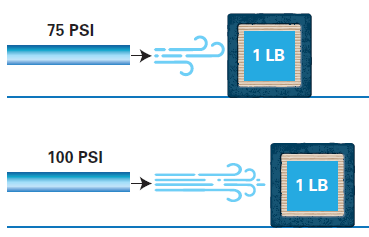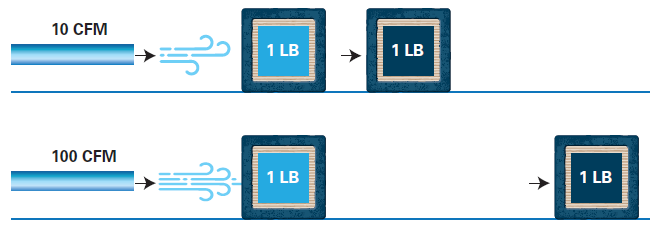Pressure and flow are two common terms when it comes to air compressor systems, but the relationship between the two is often misunderstood. Choosing the wrong compressor for your facility can lead to the inability to produce products or wasted energy that increases costs. In this article, we’ll get back to the basics of compressed air and examine the relationship between pressure and flow.
What is pressure?
Pressure, typically measured in pounds per square inch (psi), determines the system’s ability to perform a certain amount of work at any given point in time. Consider an application as simple as using compressed air to slide a wooden block across a table. In this case, using 75 psi of air might not deliver enough force to move the block but 100 psi will.

At a minimum, the compressor must provide the pressure (force) needed to perform the job (in this case, moving the block). If the minimum pressure required is 100 psi but the compressor is unable to provide this pressure, the job will not get done. However, too much pressure can damage equipment or cause it to operate erratically. Each pneumatically operated device has a stated pressure range in which it works reliably, and these specifications must be followed.
What is flow?
Flow is the ability for a compressor to continue performing the task. In the U.S., flow is typically measured in cubic feet per minute (cfm) at a specific pressure. The amount of flow depends on the length of time needed to complete the task.
Let’s look at flow using the example above:
If you only had to move the block a small distance every hour, you could use a small compressor with a compressed air storage tank. The compressor refills the tank until the next time you need to move the block. However, if your process requires the block to be constantly moving over a 24-hour period, you’ll need a larger compressor with more continuous flow.

Insufficient flow will require breaks during the process while the compressor builds up pressure in a reserve tank of air. If you begin noticing longer breaks or if your tank is not building up air pressure quickly enough, it may indicate that you have an air leak.
How do I decide what pressure and flow I need?
Pressure is determined by the job you are performing. For example, paint spraying requires very low pressure versus bottle blowing, which requires much higher pressure. The flow is determined by how many of these jobs you are performing at the same time or how often you perform them. For a given compressor (50 hp for example), flow will decrease as pressure increases and vice versa, so you need to choose a compressor that optimize your flow and pressure demands. Keep in mind that every 2 psi increase in pressure results in 1 percent more energy needed to maintain the same airflow (CFM).


 INDUSTRY NEWS
INDUSTRY NEWS



